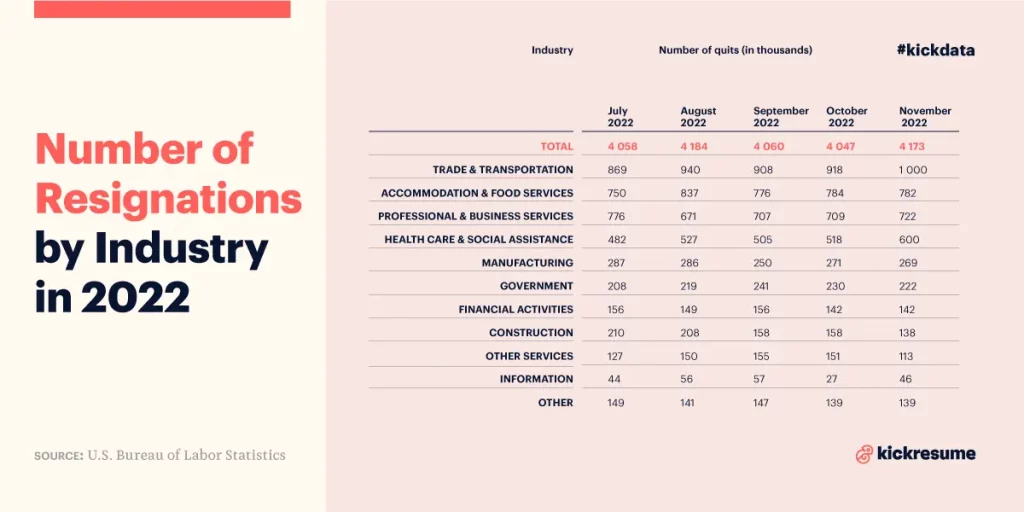Figuring out how to quit a job, whether it's a long-term position or one you just started, can be a daunting task, especially if you want to maintain good relationships and leave on a positive note.
Knowing when and how to make the leap can be difficult, and the stakes can feel high when considering the impact on your professional reputation and future opportunities.
That's why in the following sections, we'll provide a step-by-step guide on how to resign from a job professionally.
We'll cover everything from assessing your reasons for quitting, writing your resignation letter, to preparing for your final day — all while ensuring a smooth and confident transition to the next phase of your career.
So, if you're contemplating the question, "Should I quit my job?" read on to find the answers and guidance you need.
Should I stay or should I go? Factors to consider before quitting
Before making the final decision to quit your job, it's crucial to consider the factors that have led you to this point and weigh the pros and cons of leaving.
Taking the time to reflect on the reasons behind your dissatisfaction can help you make a well-informed decision and ensure that leaving your job is the right choice for your career and personal well-being.
Hence, before you decide to quit, it's crucial to pinpoint what's causing your discontent at work.
Here are five common reasons that may contribute to the decision to quit a job:
- Lack of growth and promotion opportunities. Feeling stagnant in your current role, with no room for personal development or career progression, can lead to frustration and a desire for change.
- Unsatisfactory compensation and benefits. If you feel undervalued and underpaid, and your employer isn't addressing your concerns, it may be time to seek a more financially rewarding position elsewhere.
- Poor work-life balance and excessive stress. Constantly feeling overwhelmed with work demands, struggling to find a healthy balance between your professional and personal life, and experiencing burnout can signal that it's time to reevaluate your job situation.
- Toxic work environment. Dealing with a toxic workplace culture, office politics, or strained relationships with colleagues and supervisors can take a toll on your mental and emotional well-being, prompting the need for a change.
- A desire to pursue a new career path or passion. Sometimes, the urge to explore new professional avenues, follow a passion, or embark on a different career journey can indicate that it's time to leave your current job and pursue more fulfilling opportunities.
If any of these situations sound way too familiar and you've exhausted all possible solutions to improve your circumstances, it's probably time to move on from your current job.
After all, you'll neither be the first nor the last to quit your job. In fact, quitting seems to be an ongoing economic trend, with 4 million Americans leaving their jobs every month in 2022 on average.
Check out the infographic below for a closer look at the current state of job turnover:

You will find more infographics at Kickresume Blog
In the next chapter, we'll guide you through the process of quitting professionally with a five-step approach, ensuring a smooth and respectful transition.
How to quit your job in 5 steps
Now that you've reflected on the reasons for quitting and determined that it's time to leave your current job, the next step is to ensure a professional resignation process.
In this chapter, we'll introduce five key steps that cover the essential aspects of the resignation process — from initiating the conversation with your boss to leaving a lasting positive impression on your final day.
By following this five-step approach, you'll be well-prepared to navigate this transition and set yourself up for success as you embark on a new chapter in your career.

1. Have a conversation with your boss
One of the most critical aspects of quitting your job professionally is having an open and honest conversation with your boss.
Though uncomfortable, this face-to-face interaction demonstrates respect and allows you to share your decision personally, ensuring that your boss doesn't hear the news from someone else.
To make this conversation as smooth and productive as possible, consider the following tips for scheduling and preparing for the conversation:
- Choose the right time. Schedule the meeting at a time when your boss is less likely to be swamped with work or stressed by pressing deadlines. This will ensure that they're more receptive to what you have to say.
- Prepare your talking points. Before the meeting, outline the key points you want to address, including your reasons for quitting, the positive aspects of your time at the company, and your appreciation for the opportunities you've had.
- Practice your delivery. Rehearsing your conversation beforehand can help you feel more confident and ensure that you convey your message clearly and professionally.
- Be prepared for questions. Your boss may have questions about your decision, so be ready to provide thoughtful and honest answers while also maintaining a professional tone.
This approach will help maintain a positive relationship with your employer, which can be beneficial for future networking and potential references as you pursue new career opportunities.
If you're really anxious about this conversation, have a look at our advice article: How to Tell Your Boss You’re Quitting? 10 Tips to Leave Without Drama
2. Write a resignation letter
After having a conversation with your boss, it's time to put your decision in writing by crafting a resignation letter.
This formal document serves several purposes, including:
- Officially stating your intention to resign from your position
- Providing a written record of your resignation for HR and administrative purposes
- Giving a resignation notice period (in the U.S., this is usually a two weeks' notice)
There are some key components each resignation letter should include. These are:
- Your credentials at the top
- Time and date of writing
- Recipient's address
- Resignation statement
- The final day of employment
- Reasoning, gratitude, and offering of help
- Signature
Here's an example of a resignation letter containing all essential components:

If you're unsure of the best wording or format, have a look at many resignation letter examples and templates you can download for free, or use Kickresume's AI Resignation Letter Generator to create a professional and personalized letter in minutes.
In cases when it's not possible to submit a resignation letter in-person or on paper (e.g., for remote workers), you can send a resignation email instead.
3. Make sure you give a (two weeks) notice
The notice period is the time between submitting your resignation letter and your last day of employment.
It allows both you and your employer to prepare for the transition, and it's an essential aspect of quitting your job professionally.
In the United States, while there's no legally binding notice period, it's considered common courtesy to give at least a two-week notice. However, some employment contracts may specify a longer or shorter notice period.
In most other countries, however, giving a notice period to your employer is legally binding, with individual employers specifying the length of the period in contracts.
So, make sure to check your contract!
And, how do you give notice?
To give notice, submit your resignation letter, which includes your last day of employment, at least two weeks before that date (or according to the agreed-upon notice period).
In other words, handing in your resignation letter counts as giving your notice, provided that it was submitted two weeks before your last day.
By following this practice, you'll demonstrate professionalism and considerate behavior, contributing to a smooth and peaceful transition for all parties involved.
4. Offer to help with the transition
As you prepare to leave your job, it's important to demonstrate a continued commitment to the success of the company and your colleagues by offering to help with the transition.
This gesture not only speaks to your professionalism but also ensures that you leave on good terms with your employer.
Here are some ways you can assist in the transition process:
- Document your work processes. Compile any relevant documentation or create guides outlining your work processes, making it easier for your replacement or team members to continue the tasks you were handling.
- Complete any outstanding tasks. Before your departure, wrap up any ongoing projects or assignments to the best of your ability, or provide a clear status update to your team to facilitate a smooth handover.
- Train your replacement. Offer to help onboard and familiarize your successor with your role, projects, and responsibilities, ensuring a seamless handover.
By offering your support during the transition period, you're emphasizing the importance of maintaining professionalism and leaving on good terms.
This approach not only benefits the company but also enhances your reputation as a responsible and considerate professional, which can have long-lasting positive effects on your future career.
5. Prepare for your final day
As your last day at work approaches, it's essential to tie up any loose ends and ensure a positive and memorable farewell.
Preparing for your final day involves addressing several logistical and interpersonal matters, leaving you with a sense of closure and a good lasting impression.
Here's a checklist of things to address before leaving:
- Complete any final paperwork. Double-check with HR to ensure that any necessary exit paperwork, such as benefits or payroll forms, has been completed and submitted.
- Return company property. Ensure that all company-owned items, such as laptops, mobile phones, or office supplies, are returned to the appropriate department or personnel.
- Clean out your workspace. Organize and clean your desk, drawers, and office area, leaving the space neat and ready for the next occupant.
- Deactivate access cards and accounts. Coordinate with your HR or IT department to deactivate any access cards, keys, or login credentials associated with your employment.
- Set up an out-of-office email or voicemail. Before leaving, set up an automatic out-of-office response for your email and a voicemail message, directing any inquiries to the appropriate person who will be handling your responsibilities.
- Request a reference or recommendation. This can be valuable for future job applications and networking opportunities.
In addition to these logistical tasks, a few days before your final day is also a good time to say goodbye to your coworkers and express gratitude for the experiences you've shared in a dedicated email.
Take the time to thank your team members, supervisors, and anyone else who has contributed to your growth and success at the company.

Key takeaways: How to quit a job?
In this guide, we've outlined the key steps to quitting a job professionally and ensuring a smooth and respectful transition:
- Have an open and honest conversation with your boss.
- Write a professional resignation letter.
- Provide adequate notice of your departure.
- Offer to help with the transition process.
- Prepare for your final day at work.
By following these steps and approaching the resignation process with confidence and professionalism, you can maintain positive relationships with your employer and colleagues while moving on to new opportunities.
As you embark on your next career journey, consider creating a new resume that highlights your skills and experiences.
A well-crafted resume can help you make a strong impression on potential employers, setting you up for success in your future job search. You can even turn your LinkedIn profile into a polished resume with just one click.



![How to Write a Professional Resume Summary? [+Examples]](https://d2xe0iugdha6pz.cloudfront.net/article-small-images/i-Profile.svg)
![How to Put Your Education on a Resume? [+Examples]](https://d2xe0iugdha6pz.cloudfront.net/article-small-images/i-Collage-Universities.svg)
![How to Describe Your Work Experience on a Resume? [+Examples]](https://d2xe0iugdha6pz.cloudfront.net/article-small-images/Experience.svg)


